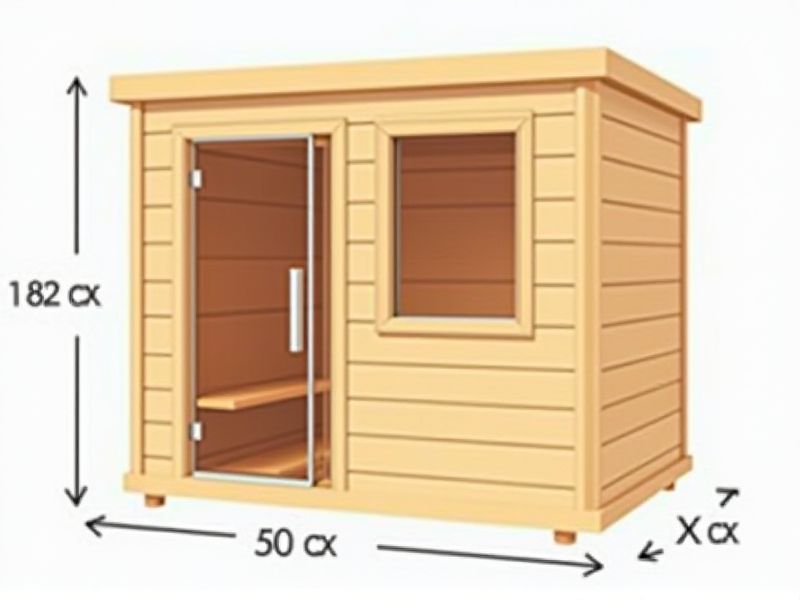
When planning a sauna, it's important to know the standard dimensions to ensure both comfort and efficiency. Most traditional saunas are designed to be around 6 feet by 5 feet (1.8m x 1.5m), which comfortably fits 2-3 people. For a larger group, a sauna measuring 8 feet by 12 feet (2.4m x 3.7m) can accommodate up to 6 or more users. Keeping in mind a minimum ceiling height of 7 feet (2.1m) allows for proper heat circulation and user comfort during sauna sessions.
Minimum Ceiling Height
The minimum ceiling height for a sauna is typically set at 7 feet (2.13 meters) to ensure adequate ventilation and comfort. This height allows for proper heat distribution, preventing hot spots and enhancing your overall experience. When designing or installing a sauna, maintaining this standard is crucial for both safety and functionality. A higher ceiling can accommodate better air circulation, improving the effectiveness of your sauna sessions.
Bench Dimensions
The standard dimensions for sauna benches typically range from 18 to 24 inches in width and 2 to 4 inches in thickness, ensuring comfort and adequate support. Height varies, with upper benches often set between 35 to 40 inches off the ground, while lower benches range from 18 to 24 inches. Creating staggered levels can enhance the sauna experience, allowing you to choose your preferred temperature, as the top level typically offers hotter air. For optimal use, ensure your sauna has sufficient space for at least 3 to 4 people, providing a social atmosphere and maximizing the benefits of thermal therapy.
Door Size
The standard sauna door size typically measures 24 to 30 inches in width and 72 to 80 inches in height, ensuring comfortable entry while maintaining heat retention. A properly sized door minimizes air exchange, which is crucial for maintaining optimal sauna temperatures between 150degF to 195degF (65degC to 90degC). Moreover, the door should be equipped with a tempered glass option or solid wood to enhance durability and aesthetic appeal. Prioritizing these dimensions in your sauna design maximizes both safety and user experience, allowing you to enjoy the health benefits of regular sauna use effectively.
Floor Area
The standard floor area for a sauna typically ranges from 2.3 square meters (25 square feet) for a small, two-person sauna to approximately 11 square meters (120 square feet) for larger models accommodating six or more people. In Finland, the recommended minimum size for public saunas is around 4-6 square meters (43-64 square feet), ensuring ample space for ventilation and comfort. Proper floor area also helps maintain optimal heat distribution, with temperatures usually set between 70degC to 100degC (158degF to 212degF) for an effective experience. When planning your sauna, consider both the floor area and ceiling height, as higher ceilings can help create a more enjoyable atmosphere.
Room Ventilation
Room ventilation is crucial for maintaining an optimal sauna environment, ensuring that humidity levels remain balanced and that air quality is fresh. Proper ventilation systems facilitate the exchange of indoor and outdoor air, typically requiring at least 60 cubic feet per minute (CFM) to promote effective airflow. Effective ventilation allows for the removal of excess moisture, which can otherwise contribute to mold growth and deterioration of materials. You should consider integrating adjustable vents to tailor your sauna's air quality to personal comfort levels.
Heater Clearance
A sauna heater clearance is crucial for safety and optimal performance, with standard guidelines typically requiring a minimum distance of 4 inches from combustible materials. Maintaining this clearance prevents overheating and reduces the risk of fire hazards, ensuring a safe environment for users. The heater's location should also comply with manufacturer specifications, which often recommend placing the unit at least 12 inches from any wall for proper ventilation. You can enhance your sauna experience by regularly checking and adhering to these clearance requirements, maximizing both safety and efficiency.
Wall Spacing
The ideal wall spacing in a sauna is typically between 6 to 8 inches, ensuring optimal heat circulation and preventing moisture accumulation. Each wall should be insulated effectively, often using mineral wool or fiberglass, to maintain temperatures ranging from 150degF to 195degF. Spacing allows for the installation of proper venting systems, which is crucial for maintaining air quality and temperature consistency. When designing your sauna, consider these measurements to enhance your therapeutic experience.
Entrance Space
The entrance space of a sauna is crucial for creating an inviting atmosphere, typically ranging from 40 to 60 square feet. This area is designed to accommodate seating, storage for towels, and hooks for clothing, enhancing practicality and comfort. You can customize the entrance with natural materials, such as cedar or hemlock, which are known for their durability and aromatic properties. Proper ventilation in this space, with airflow exchanges of about 1 to 2 per hour, ensures a fresh experience as you transition into the sauna environment.
User Capacity
The standard capacity for a sauna typically ranges from 2 to 8 people, allowing for a comfortable and relaxing experience. In residential settings, a 4-person sauna measures around 6 feet by 4 feet, making it an ideal choice for families or small groups. Commercial saunas often accommodate larger groups, with capacities exceeding 10 individuals in spaces that range up to 12 feet in length. Ensuring proper user capacity not only enhances the overall sauna experience but also promotes safety and efficient heat distribution.
Insulation Thickness
The standard for sauna insulation typically requires a thickness of at least 4 to 6 inches to ensure optimal heat retention and energy efficiency. High-density materials, such as fiberglass or mineral wool, are commonly used to minimize heat loss, with R-values of 19 or higher ideal for sauna walls. Proper insulation reduces the need for excessive energy consumption, saving you money on heating costs while maintaining the sauna's temperature. Investing in quality insulation not only enhances the overall sauna experience but also prolongs the lifespan of the wooden structures by preventing moisture buildup.
